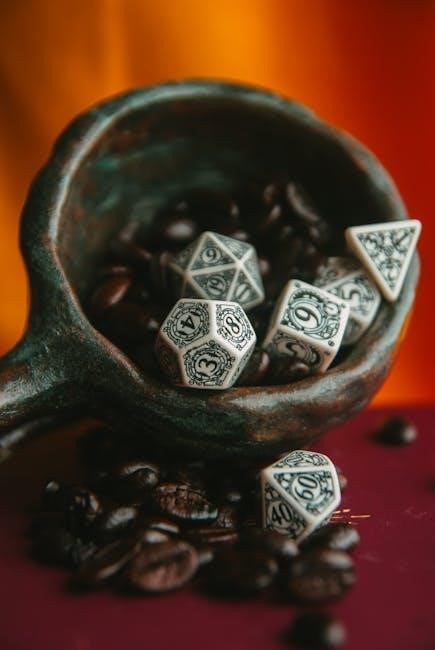
dungeons and dragons 3.5 dungeon master’s guide pdf
The Dungeon Master’s Guide 3.5 is a core rulebook for D&D 3.5 Edition, offering tools and resources for creating immersive worlds, adventures, and gameplay experiences. Essential for DMs, it provides detailed guidance on magic, monsters, and world-building, making it indispensable for crafting unique campaigns and narratives.
Overview of the DMG 3.5 Edition
The Dungeon Master’s Guide 3.5 Edition is a comprehensive rulebook designed to empower Dungeon Masters (DMs) with the tools and resources needed to craft immersive and dynamic campaigns. It serves as one of the three core rulebooks in the D&D 3.5 Edition, alongside the Player’s Handbook and Monster Manual. The DMG 3.5 provides detailed guidance on world-building, magic item creation, monster statistics, and game mechanics, allowing DMs to customize their games and create unique experiences for players. It also includes optional rules and systems to enhance gameplay flexibility. As a cornerstone of the D&D 3.5 system, this guide is indispensable for both new and experienced DMs, offering everything needed to run a compelling and engaging adventure.
Importance of the DMG for Dungeon Masters
The Dungeon Master’s Guide 3.5 Edition is a vital resource for Dungeon Masters, providing essential tools and guidelines to create and manage engaging campaigns. It offers detailed advice on world-building, encounter design, and game mechanics, ensuring that DMs can craft unique and balanced adventures. The DMG also includes extensive libraries of magic items, spells, and monsters, allowing for rich storytelling and diverse challenges. Its comprehensive nature makes it a cornerstone for both novice and experienced DMs, enabling them to refine their skills and deliver memorable experiences for their players. Without the DMG, the depth and complexity of D&D 3.5 Edition gameplay would be significantly diminished, making it an indispensable companion for any aspiring or established Dungeon Master.
Structure and Content of the DMG
The Dungeon Master’s Guide 3.5 Edition is meticulously structured to provide comprehensive support for Dungeon Masters. It begins with foundational chapters on creating campaigns and running games, offering insights into world-building and adventure design. Subsequent chapters delve into specific elements like magic items, monsters, and treasure, each detailed with mechanics and narrative potential. The guide also covers character customization, offering DMs tools to personalize player experiences. Advanced topics such as epic-level play and psionics expand the game’s scope. The DMG concludes with practical resources, including random treasure tables and encounter generators, ensuring versatility and adaptability. This structured approach ensures that DMs have access to a wealth of information, enabling them to craft unique and engaging campaigns with ease and precision, making the DMG an essential toolkit for any D&D 3.5 Edition game.

Key Chapters in the Dungeon Master’s Guide 3.5
The DMG 3.5 includes chapters on creating campaigns, running games, designing adventures, magic items, monsters, characters, treasure, and world-building, each providing detailed mechanics and narrative tools for DMs.
Chapter 1: Creating a Campaign
Chapter 1 of the Dungeon Master’s Guide 3.5 focuses on the fundamentals of building a compelling campaign. It provides guidance on setting up the game world, including geography, history, and cultures, which form the backbone of any immersive adventure. DMs learn how to establish the campaign’s tone and theme, whether it’s a high-fantasy epic or a darker, grittier tale. The chapter also covers creating non-player characters (NPCs) with depth and motivation, helping to populate the world with believable inhabitants. Additionally, it offers practical advice on balancing player options and narrative elements to ensure a dynamic and engaging experience. This section is crucial for new and veteran DMs alike, offering a roadmap to crafting memorable and cohesive campaigns that captivate players.
Chapter 2: Running the Game
Chapter 2 of the Dungeon Master’s Guide 3.5 delves into the practical aspects of managing a session. It offers tips on pacing, narration, and maintaining player engagement. DMs learn how to handle combat encounters, resolve conflicts, and adjudicate rules creatively. The chapter emphasizes the importance of improvisation and flexibility, ensuring smooth gameplay even when players diverge from planned scenarios. It also provides advice on creating dynamic descriptions and using props to enhance immersion. This section is a handbook for DMs to master the art of storytelling and refereeing, making it an invaluable resource for both newcomers and experienced game masters aiming to deliver memorable experiences.
Chapter 3: Creating Adventures
Chapter 3 focuses on crafting compelling adventures, guiding DMs through designing engaging stories, encounters, and environments. It explores techniques for building balanced challenges, incorporating NPC interactions, and creating meaningful treasure rewards. The chapter emphasizes thematic consistency and player agency, helping DMs tailor adventures to their party’s strengths and preferences. It also covers pacing, ensuring a mix of combat, exploration, and role-playing opportunities. With practical advice on structuring quests and integrating plot hooks, this chapter equips DMs with the tools to create memorable and dynamic adventures that captivate players and enrich the campaign world.
Chapter 4: Magic Items
Chapter 4 delves into the creation, customization, and balance of magic items, a cornerstone of D&D 3.5. It provides detailed guidelines for crafting unique magical weapons, armor, and miscellaneous items, ensuring they align with the game’s mechanics. DMs learn how to set item properties, determine costs, and integrate these items seamlessly into their campaigns. The chapter also offers a vast array of pre-made magic items, categorized for easy reference, allowing DMs to enhance their game world with enchanted treasures. Additionally, it addresses the challenges of managing item distribution to maintain game balance, ensuring that magic items remain rewarding without overshadowing other aspects of gameplay. This section is invaluable for DMs seeking to enrich their worlds with magical elements.
Chapter 5: Monsters
Chapter 5 of the DMG 3.5 Edition is dedicated to the vast array of monsters that inhabit the world of Dungeons & Dragons. This section provides detailed descriptions, stat blocks, and lore for a wide variety of creatures, from classic fantasy beasts like dragons and giants to more unique and exotic entities; DMs can use this chapter to populate their campaigns with appropriate challenges, ensuring encounters are balanced and engaging. The chapter also includes guidelines for creating custom monsters, allowing DMs to craft unique adversaries tailored to their stories. Additionally, it covers how to integrate monsters into adventures, including tips on encounter design and treasure allocation. This comprehensive resource is essential for any DM aiming to create immersive and dynamic combat experiences for their players, making it a cornerstone of the DMG.
Chapter 6: Characters
Chapter 6 of the DMG 3.5 Edition focuses on character creation and development, offering essential resources for both players and DMs. This section provides insights into character races, classes, and customization options, allowing for the creation of unique and diverse characters. It includes detailed information on character backgrounds, skills, and feats, as well as guidance on how to balance characters within a party. Additionally, the chapter offers tips for DMs on integrating characters into the game world, managing character progression, and handling character-specific storylines. This chapter is crucial for building well-rounded characters that enhance the overall narrative and gameplay experience. By utilizing the content in Chapter 6, DMs can help players craft memorable characters that drive the story forward and immerse themselves in the world of Dungeons & Dragons.
Chapter 7: Treasure
Chapter 7 of the DMG 3.5 Edition delves into the art of creating and distributing treasure, a cornerstone of the Dungeons & Dragons experience. This section provides comprehensive guidelines for generating treasure hoards, including tables for random treasure generation based on party level and campaign settings. It details the distribution of magical items, gems, and other valuables, ensuring balanced and engaging rewards for players. Additionally, the chapter offers advice on integrating treasure into the game world, tying it to storylines, and creating memorable encounters. With this chapter, DMs can craft meaningful rewards that enhance gameplay and deepen the narrative, making every treasure discovery a thrilling experience for players. The content is designed to help DMs tailor treasure to their campaign’s unique flavor and themes.
Chapter 8: World-Building
Chapter 8 of the DMG 3.5 Edition is dedicated to the art of world-building, providing tools and techniques for Dungeon Masters to craft unique and immersive campaign settings. This section offers guidance on creating detailed geographies, climates, and cultures, allowing DMs to build rich, believable worlds. It includes methods for designing cities, towns, and landscapes, as well as tips for integrating history, politics, and mythology into the game environment. The chapter also explores how to populate the world with NPCs, organizations, and factions, giving depth and life to the setting. Additionally, it provides advice on customizing the world to suit the preferences of the players and the ongoing narrative of the campaign. This chapter empowers DMs to create dynamic, engaging worlds that captivate and inspire their players, making every adventure feel unique and memorable.

Advanced Topics in the DMG 3.5
The DMG 3.5 covers advanced topics like epic-level play, psionics, and dragon magic, offering detailed rules and expansions to enhance high-level campaigns and complex world-building.

Epic Level Handbook Integration
The Epic Level Handbook integrates seamlessly with the DMG 3.5, providing rules for characters beyond level 20. It introduces epic feats, spells, and abilities, allowing for high-stakes, legendary gameplay. DMs can craft epic-tier adventures with powerful artifacts and legendary monsters, creating unparalleled challenges. This supplement enhances the core DMG 3.5 rules, offering detailed guidance for epic-level campaigns. It ensures continuity and balance, making high-level play engaging and immersive. With epic magic, divine and arcane spellcasting reaches new heights, while epic monsters test even the most formidable parties. The integration of the Epic Level Handbook into the DMG 3.5 framework expands the game’s potential, enabling epic storytelling and limitless possibilities for advanced players and DMs alike.
Expanded Psionics Handbook
The Expanded Psionics Handbook is a supplement that enriches the psionic system in D&D 3.5. It introduces new classes, such as the psion, psychic warrior, and soulknife, each with unique abilities and progression. The handbook expands on psionic feats, powers, and prestige classes, offering DMs a wealth of options to create psionic characters and encounters. It also provides rules for crafting psionic items, enhancing the integration of psychic elements into campaigns. This resource is fully compatible with the DMG 3.5, ensuring seamless gameplay mechanics. By incorporating psionics into their games, DMs can add depth and variety, creating new challenges and narrative possibilities for players. The Expanded Psionics Handbook is a must-have for those seeking to explore the mysteries of the mind in their D&D campaigns.
Dragon Magic and Other Supplements
Dragon Magic and other supplements enhance the D&D 3.5 experience by introducing new content. Dragon Magic focuses on draconic themes, offering spells, feats, and prestige classes tied to dragons. It allows players to harness dragon-like abilities and interact with dragon characters. Other supplements expand on specific campaign settings, such as Eberron or Forgotten Realms, providing region-specific rules, creatures, and plot hooks. These resources enrich the DM’s toolkit, enabling the creation of unique worlds and adventures. By incorporating these supplements, DMs can diversify gameplay, deepen lore, and cater to varied player interests. They are invaluable for crafting intricate, engaging stories and expanding the possibilities within the D&D 3.5 framework. These additions ensure that no two campaigns are alike, keeping the game fresh and exciting for both new and veteran players.

Resources and Tools for Dungeon Masters
Essential tools like the Dungeon Master’s Screen and official character sheets streamline gameplay. Miniatures and battlemats enhance tactical combat, while digital PDFs provide easy access to rules and content.
Dungeon Master’s Screen
The Dungeon Master’s Screen is a versatile tool designed to enhance gameplay efficiency. It typically consists of a three-panel screen that displays essential tables, rules, and reference materials, allowing DMs to quickly access critical information during sessions. This resource helps maintain immersion by keeping key details out of players’ sight. The screen often includes charts for combat, skill checks, and spell effects, streamlining decision-making. Many DMs find it indispensable for managing complex rules and stats. Paired with the Dungeon Master’s Guide, it provides a comprehensive system for running smooth and engaging games. Digital versions of the screen are also available as PDFs, offering convenience for modern DMs. Its portability and practicality make it a cornerstone in every Dungeon Master’s arsenal, whether they are seasoned veterans or newcomers to the role.
Character Sheets and Record Keeping
Character sheets and record-keeping tools are essential for organizing player and non-player character details in D&D 3;5. These sheets typically include sections for tracking stats, skills, spells, equipment, and experience points. DMs use these records to manage campaign progression, ensuring consistency and fairness. Official character sheets are available in PDF format, offering a structured layout for players to document their characters’ evolution. Additionally, custom sheets and digital tools allow for personalized record-keeping, catering to different playstyles. Proper record management enhances gameplay by reducing confusion and enabling seamless narrative flow. It also helps DMs maintain detailed notes on NPCs, plot threads, and world-building elements. Effective record-keeping is a cornerstone of successful campaign management, making it a vital practice for both players and DMs alike in the D&D 3.5 system.
Miniatures and Battlemats

Miniatures and battlemats are integral components for enhancing tactical combat in D&D 3.5. The DMG 3.5 Edition emphasizes the use of these tools to visualize battles, adding depth to gameplay. Miniatures represent characters and monsters, allowing precise positioning on a grid. Battlemats, whether physical or digital, provide a shared space for tracking movement and encounters. The integration of D&D miniatures lines, as mentioned in the DMG, offers official figures that align with game mechanics. These tools not only aid in resolving complex combat scenarios but also immerse players in the game world. The DMG provides guidance on using miniatures effectively, ensuring they complement the storytelling experience. This section highlights how these visual aids enhance the tactical aspects of the game, making combat encounters more engaging and strategic for players and DMs alike.

Digital Versions and PDF Availability
Digital versions of the D&D 3.5 DMG are widely available as PDFs, offering convenience for Dungeon Masters. Official releases ensure quality and legality, preserving the book’s integrity for modern play.
Official PDF Releases
Official PDF releases of the Dungeons & Dragons 3.5 Dungeon Master’s Guide are available through reputable platforms like Wizards of the Coast’s official website and partner retailers. These digital versions are meticulously scanned and formatted to preserve the original content’s quality, ensuring that all illustrations, charts, and rules are presented clearly. The PDFs are optimized for readability on various devices, making it convenient for Dungeon Masters to access the guide during game preparation or play. Purchasing the official PDF supports the creators and ensures compliance with copyright laws. Additionally, these releases often include bookmarks and searchable text, enhancing usability for quick reference during sessions.
Online Platforms for DMG 3.5 PDF
Several online platforms offer the Dungeon Master’s Guide 3.5 in PDF format, catering to the convenience of digital access. Wizards of the Coast’s official website and platforms like DriveThruRPG are reliable sources, providing high-quality scans of the original book. These platforms ensure that the PDFs are legally distributed, supporting both the game’s legacy and its creators. Additionally, online marketplaces and forums often host discussions and links to these resources, making it easier for Dungeon Masters to find and download the guide. Purchasing through these official channels guarantees authenticity and contributes to the ongoing support of the D&D franchise, while also offering the flexibility to access the content on various devices for seamless gameplay preparation and execution.

Legal Considerations for Digital Copies
Accessing digital copies of the Dungeon Master’s Guide 3.5 requires adherence to copyright laws and licensing agreements. Official PDFs are available through platforms like Wizards of the Coast’s website and DriveThruRPG, ensuring legal distribution. Purchasing from these sources supports the creators and maintains the integrity of the game. Sharing or downloading pirated copies is illegal and undermines the RPG community. Always verify the authenticity of the source to avoid infringing on intellectual property rights. Respect for these guidelines ensures the continued availability of high-quality resources for Dungeon Masters and players alike, fostering a sustainable and ethical gaming community.

Community and Fan-Created Content
The D&D 3.5 community thrives through fan-created content, including homebrew adventures and custom rules. Enthusiasts share their creations online, expanding the game’s possibilities and fostering creativity among players and DMs.
Homebrew Adventures and Rules
Homebrew adventures and custom rules are a vibrant part of the D&D 3.5 community, allowing players and DMs to craft unique experiences. Fans create and share original scenarios, character classes, and mechanics, expanding the game’s possibilities. These creations often reflect personal creativity, offering fresh perspectives on classic themes. Websites and forums host a wealth of homebrew content, from intricate storylines to balanced rule modifications; Many enthusiasts appreciate the flexibility of 3.5 Edition, which lends itself well to customization. Whether refining existing systems or inventing new ones, homebrew content keeps the game dynamic and engaging. This community-driven innovation ensures that D&D 3.5 remains a timeless and adaptable platform for storytelling and adventure.

Fan-Made PDF Guides and Supplements
Fan-made PDF guides and supplements for D&D 3.5 Edition are abundant, showcasing the community’s dedication and creativity. These resources include detailed character sheets, adventure modules, and rule expansions, often designed to enhance gameplay. Platforms like forums and file-sharing sites host these PDFs, offering players and DMs new tools to enrich their campaigns. Many fan creations are meticulously crafted, with polished layouts and original artwork, rivaling official content in quality. These supplements cover a wide range of topics, from unique magic systems to exotic campaign settings, providing endless inspiration for custom stories and mechanics. By sharing these works, fans contribute to the game’s enduring popularity, ensuring D&D 3.5 remains a vibrant and evolving hobby.


Leave a Reply
You must be logged in to post a comment.